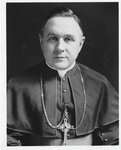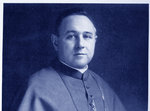


As the Diocese of Providence celebrates its 150th anniversary through June 26, 2022, Rhode Island Catholic is featuring profiles of the eight men who have served as diocesan shepherds through its history.
PROVIDENCE — After Bishop William A. Hickey suffered a heart attack and died on October 4, 1933, at the age of 64, the entire state mourned his passing. Msgr. Peter Blessing was called to serve as interim administrator.
Four months later, on Feb. 12, 1934, the apostolic delegate to the U.S. announced that the Holy See had appointed Father Francis P. Keough, a priest of the Archdiocese of Hartford, as the fourth Bishop of Providence.
Bishop Keough was born on Dec. 30, 1890, in New Britain, Connecticut, into a deeply Catholic family. He was named after Bishop Francis P. McFarland, at the insistence of his aunt. After attending St. Mary’s, his parish school, he went on to St. Thomas Seminary in Hartford. Francis Keough then journeyed to France, where he attended the Seminary of St. Sulpice in Issy, near Paris.
When World War I broke out in Europe in 1924, he was called home, where he completed his theological studies at St. Bernard’s Seminary in Rochester, New York.
He was ordained to the priesthood on June 10, 1916, and was assigned to serve as an assistant at St. Rose Church in Meriden, Connecticut. After a few years, he was assigned to the cathedral in Hartford, where he served as diocesan director of the Society for the Propagation of the Faith, and became assistant chancellor.
On May 22, 1934, Father Francis Keough was ordained Bishop of Providence.
Bishop Keough became a diocesan shepherd as the citizens of Rhode Island were still struggling with the impact of the Great Depression. Seven years later, World War II broke out, presenting even more challenges.
But despite these difficult times, the Catholic population in Rhode Island, under Bishop Keough’s tenure, increased by almost one-third, from 328,528 in 1934 to 427,364 in 1948. Also during this time, there was a significant increase in the number of clergy serving in the diocese. When he took office in 1934, there were 270 diocesan and 95 religious priests. By 1948, the number of diocesan priests was 344 (an increase of 74 priests), while there were 145 religious priests (an increase of 50). It was due to this increase in priests that Bishop Keough was able to found 15 new parishes, most of which had begun as mission churches. Several of the new parishes founded by Bishop Keough were located in the southern part of the state to provide better access for Catholics living there.
As a graduate of a minor seminary himself, Bishop Keough sought to establish a similar institution in the Providence diocese. In preparation for this, he began sending priests to graduate schools in 1937. The following year, the devastating 1938 hurricane unexpectedly created a site for the new seminary he envisioned.
With the hurricane inflicting substantial damage to the Warwick Neck estate of former Sen. Nelson W. Aldrich, the senator’s son, Edward, was faced with tremendous costs for repairing the mansion. As Edward also had disagreements with the town over its tax valuation of the property, he decided to sell the estate to the diocese for about $75,000. After two years of renovation, Bishop Keough opened Our Lady of Providence Seminary on the property in the fall of 1939.
Bishop Keough also saw the opening of the first Catholic college for women in the diocese, built upon an idea that former Bishop Hickey had envisioned as early as 1926. In September 1947, the Sisters of Mercy welcomed their first students to Salve Regina College in Newport.
At the secondary school level, Bishop Keough oversaw the creation of four Catholic high schools for girls in the diocese, including St. Catherine’s Academy, Newport. The other three were established at parishes: St. Patrick’s, Providence; Notre Dame, Central Falls, which expanded its two-year commercial course for girls into a four-year program; and St. Charles, Providence.
As a diocesan leader, Bishop Keough brought a successful blend of administrative talent and a gracious personality to his position.
“As assistant chancellor in Hartford, and later as Bishop of Providence, Francis P. Keough showed an innate capacity for administrative and executive work. He combined these talents with a gracious personality and a rare gift of friendliness,” said Father Robert W. Hayman, Ph.D., of Bishop Keough in his book “The Diocese of Providence: A Short History 1780-2000.” Father Hayman also serves as historian and archivist for the diocese.
Bishop Keough voiced his concerns for the sick, poor, orphaned and elderly in his diocese. During his tenure, gifts to the annual Catholic Charity Fund — which was initiated by his predecessor Bishop Hickey — increased from $262,563 in 1933 to nearly $1 million in 1948. The significant rise in contributions came about through the strong leadership of Bishop Keough and the zeal of pastors and parishioners participating, coupled with the return of prosperity following World War II.
Programs for youth also thrived during this time after Bishop Keough expressed concern about the lack of programs for young people in the diocese. Scout troops were formed in parishes and a local Catholic Youth Organization was founded. It sponsored basketball leagues composed of teams organized by the various parochial schools, as well as summer baseball leagues.
Parishes and parochial schools were very active in promoting patriotism during World War II. Students were called upon to serve as sales agents for war bonds and stamps. Numerous parishes also held wartime services during which the pastors blessed national and papal flags, which were then set up in sanctuaries. Patriotic services were held, along with novenas.
In 1942, Bishop Keough was recognized by the state government for his role as a community leader. He was asked to give the blessing at the launching of the first Liberty ship built in the Rheem Shipyard at Field’s Point in Providence.
Also during this time, 29 diocesan and religious order priests from the diocese volunteered to serve as chaplains in the armed forces. Two of them, Father Valmore Savignac (1942), and Father Anthony E. Czubak (1945), were killed in the war.
In December 1947, Bishop Francis P. Keough was elevated to Archbishop of Baltimore, where he was installed on February 24, 1947. He would serve as archbishop for 14 years until he died from cerebral thrombosis on December 8, 1961, at the age of 70.